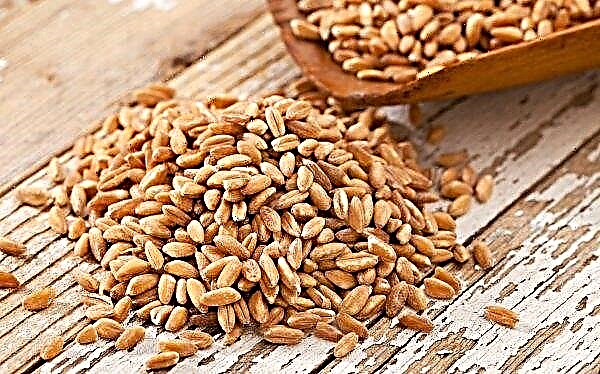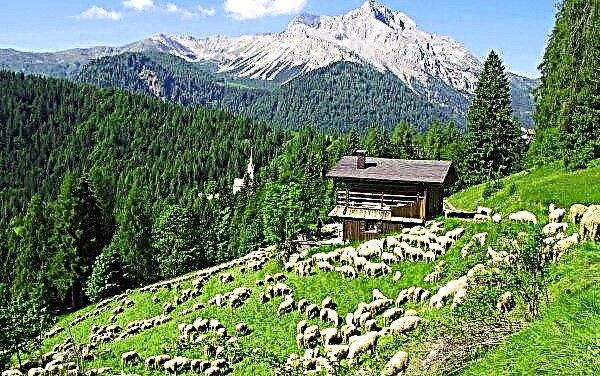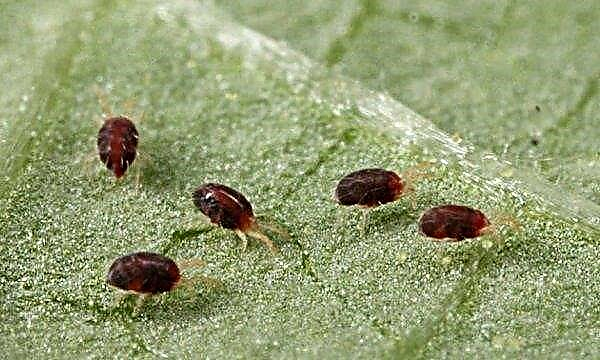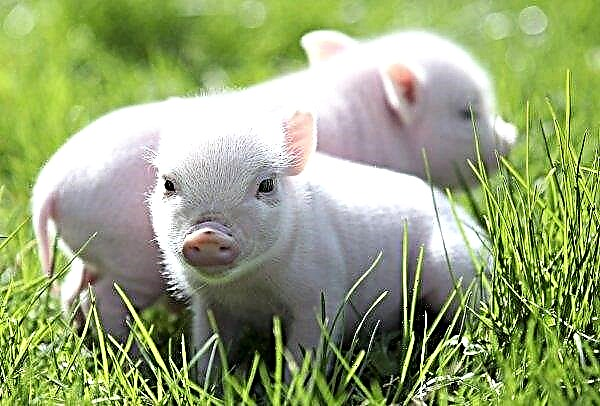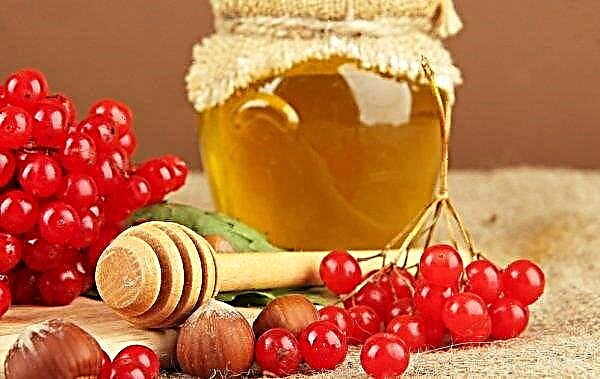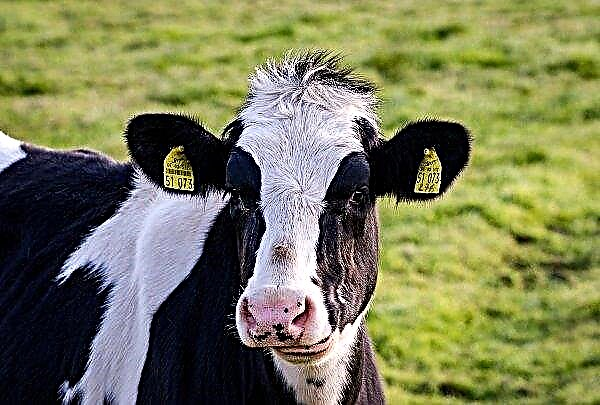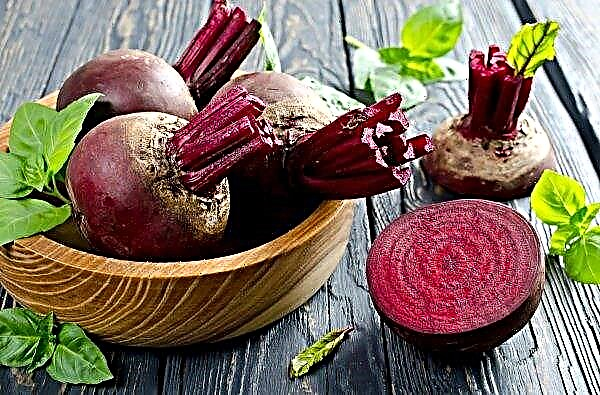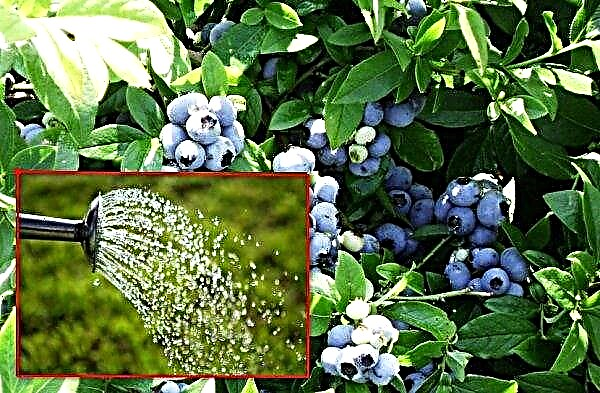Afelandra came to us from the tropics of the American continent. This plant looks beautiful and exotic, thanks to the large leaves and interesting flowers. It is also valued for its long flowering, which occurs mainly in the fall, when many indoor flowers have already faded. Consider what kind of afelander plant, how to care for it, and what signs are associated with it.
Botanical description of the plant
This evergreen plant in nature grows in the tropics, and sometimes in the subtropics of the southern and central parts of America. Belongs to the Acanthus family. According to the Internet project The Plant List, the genus Afelander has 196 species.
Afelandra has the appearance of shrubs forming shrubs up to 1-2 m high (in the wild). The leaves are large, in some species veins of a whitish color are clearly distinguished, which makes the foliage variegated. Blooms spike-like inflorescence, similar to a cone. The flower has two lips - the upper has two denticles, and the lower consists of three blades. Leaves close to the inflorescence are usually brightly colored.Did you know? The name of the afelander is made up of a pair of Greek words translated into Russian as “simple” and “man”. This plant received this designation due to the fact that it has flowers with simple single-nosed anthers.
Details:
| Stem | Fat, fleshy, erect |
| Leaf shape | Large, oval with pointed ends |
| Leaf color | Green or motley |
| Flower shape | two-lip |
| Flower color | yellow, orange, red, lilac |
| Fruit shape | box |
Main types
The following types of afelander are grown as indoor plants:
- Golden (orange). It has large leaves (up to 25 cm) with noticeable silvery veins that give the plant a beautiful mottled appearance. It blooms for about a week, throwing out an inflorescence 10-15 cm long with bright orange flowers. Especially popular is its variety - Afelander Retzl.

- Protruding. It also has variegated leaves up to 20-30 cm long, but their lower part is lighter than the upper. It blooms with a pineal inflorescence of a tetrahedral shape up to 30 cm long and bright yellow flowers that are beautifully shaded by orange bracts. It features long flowering - from May-June to November.

- Four-sided. It grows to a meter and blooms with spectacular scarlet flowers. It has a simple green leaf color.
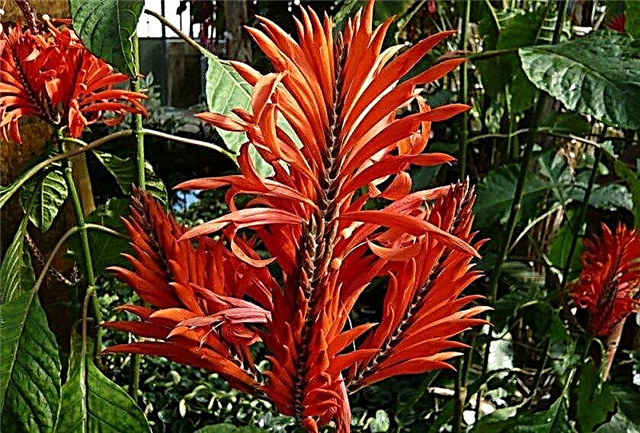
- Sinclair. It has the largest sizes - about 3 m. It has green foliage with pressed veins and beautiful orange or pink colors of large inflorescences.

House growing conditions
For this capricious indoor flower, it is necessary to create optimal conditions, otherwise it will dump its beautiful leaves.
Lighting
If this plant is illuminated for less than 8 hours, it needs to be illuminated with a phytolamp. With a lack of light, it stretches out, does not look so decorative and ceases to bloom. Afelandra prefers diffused light, and the direct rays of the sun can cause her a burn, so the plant is shaded from the sun.
Temperature
This flower from the tropics loves warmth and requires a temperature regime of + 18 ... + 25 ° С. The room conditions are quite suitable for him, but you need to make sure that there are no drafts when ventilating the room. In winter, it is recommended to lower the temperature to + 16 ° C. Lowering the temperature below + 13 ° C negatively affects the plant.
Air humidity
Afelandra loves humid air; It is recommended to spray it daily from a small spray bottle. This is especially true during the heating season, when the batteries are very dry air. Water for spraying is used boiled. It is useful to do ventilation, but so that the plant does not suffer from cold and draft.
With insufficient air humidity, the flower becomes sensitive to many diseases and discards leaves. The first to signal a lack of moisture will be that at the afelander the tips of the leaves will begin to dry.
In order not to spray the plant all the time with dry air, it is recommended to place a pallet with decorative pebbles under it, which is moistened with water. Such hydration is enough for a long time.
Home Care
A whimsical flower such as Afelander should be carefully looked after. Next to him, it is better not to put other flowers - he does not like the neighborhood. The plant is transplanted every year, pick up nutrient soil for transplantation, properly watered and fertilized.
Watering
In hot time, the plant requires more frequent watering - you must not allow drying or waterlogging of the soil. Usually in the summer you have to water the plant every other day. In winter, watering is less frequent (1 time per week) and not so plentiful, but the earth should always be moistened.
Important! Water must be soft and room temperature. It is necessary to water under the root, preventing water from entering the foliage.
For irrigation, it is best to use rainwater or melt, but you can use the cooled boiled tap water from the kettle.
Top dressing
Such a fast-growing flower, like Afelander, requires fertilizing at least 1 time per month, but from March to November - every 2 weeks.
The following fertilizers are suitable for top dressing:
- Bona Forte
- "Agricola";
- "Baikal EM-1";
- Energen.
After buying or replanting this capricious flower, it is recommended to feed it “Bona Forte Adaptation”, as it contains all the substances that help the plant overcome stress from changes.
Pruning
Afelandra is growing rapidly and needs frequent updates. This plant can be updated with cropping, shortening the shoots to 25 cm - it helps to maintain its compactness and decorativeness, helps to increase the number of peduncles. This procedure is carried out in late winter or early spring, shortly before the start of the growing season. Then, the trimmed plant is sprayed and a bag is placed on top of it to maintain the necessary moisture, or spraying is often repeated.
Important! If the plants are not trimmed, they will stretch out and turn into bushes with bare stems.
Transfer
To maintain a beautiful aesthetic appearance, young Afelanders are transplanted every year. Plant transplants, which are more than 3 years old, are carried out once every 3-4 years. The process itself is recommended to be carried out in early spring.
You can buy for transplanting soil for indoor plants with an acidity of 5.5–6.5 Ph, but it is easy to prepare it with your own hands.
To do this, you can make the following mixtures:
- turf soil from a garden plot, dry peat and coarse river sand in a ratio of 2/1/1;
- soil for flowering indoor plants, dry peat and coarse river sand in a ratio of 6/3/2;
- turf, coarse sand, dry peat, humus (4/1/1).
When transplanting, the pot should be taken 6-7 cm larger in diameter than the indoor flower itself, and always with a sufficient drainage hole. It is best that it be made of unglazed ceramics.
When carrying out a transplant, you must adhere to the following recommendations:
- First, pour plenty of room flower.
- After 4-5 minutes, when the soil absorbs moisture well, carefully remove the plant from the pot. Then rinse under running tap water.
- The root system should be examined. Dried, spoiled and broken roots are cut off at an angle of about 45 ° with a knife, which is pre-washed for disinfection with a solution of manganese.
- The slice must be treated with activated carbon powder.
- At the bottom of the tank for planting, it is necessary to place a drainage with a layer of 3-5 cm from expanded clay, pebbles or gravel.
- Pour 1/3 pot into the prepared soil and place the afelander vertically in it, being careful not to damage the roots.
- Cover the plant with soil, and carefully tamp. The soil should not reach the edge of the pot by 1.5-2 cm.
- Water the houseplant and put in the place chosen for it.
Breeding
Propaganda can be propagated in two ways - cuttings and seeds.
Cuttings
Most often, cuttings are used to propagate this houseplant. Cuttings are cut only from an adult and completely healthy specimen. This process is best done in the spring.
The cuttings are cut in length by 10-15 cm. Each must have at least 2 leaves and a tip. At first, the cut stalk weakly develops.
In order to root such a plant well, you need to adhere to the following recommendations:
- cut tops for cuttings are placed in a solution of a growth stimulator (“Heteroauxin”, “Epin”);
- the cut area is briefly placed in coal powder, and then placed vertically in moistened sand or a mixture of sand with peat;
- on top you can cover with a glass or plastic jar to maintain moisture levels. It is removed daily for 12-15 minutes for the ventilation procedure;
- recommended conditions for grafting - temperature range within + 22 ... + 25 ° C, high humidity.
Afelander can also be propagated by rooting leaves - this process proceeds in the same way as rooting cuttings. But it is not as effective as other methods of reproduction.
Seed cultivation
To get high-quality seed material, you must adhere to the following procedure:
- Prepare the soil for planting by mixing coarse sand with peat. The mixture should be decontaminated by baking in the oven or pan. Additionally, you can pour a solution of manganese.
- Place the seeds in the prepared soil with an interval of 2 cm. Pour a layer of finer sand on top and pour over water.
Important! Seeds quickly lose their ability to germinate, so they should be planted in the ground immediately after collection.
- Cover the pot or container with planting on top with a plastic bag to create greenhouse conditions. Remove the film for 5-10 minutes daily for ventilation.
- Optimum conditions for germination - temperature + 21 ... + 23 ° С, good illumination, high humidity.
- The soil as it dries must be moistened with spraying.

Possible growing difficulties
Although afelander is relatively resistant to diseases and pests, sometimes there are some problems with its content.
Does not bloom
If the lack of color occurs in the protruding afelander, this is due to non-compliance with the necessary growing conditions. This variety needs a dormant period after flowering is completed - for this, the temperature and the amount of watering are reduced.
In other cases, the reason for the lack of color is the lack of nutrients in the soil. To eliminate this problem, you need to make the appropriate feeding.
Flowering may be absent due to lack of light.
Disease
Basically, the afelander is exposed to fungal diseases that arise due to excessive watering, as well as when using non-disinfected soil for planting, lack of drainage.
Consider the main ones:
- Kinespore. This is a fungal disease, which is expressed in the appearance of black-brown spots on the leaves, they gradually become wrinkled and die off. To combat the disease, all diseased leaves are removed and fungicide is used.

- Leaf spotting. It is expressed in the appearance of brownish wet spots on the leaves. The cause is often too high humidity when rooting cuttings and contaminated soil. To eliminate this problem, the affected areas of the plant are removed, the soil is changed, and fungicides are treated at least 3 times.
- Root rot. The main symptom of the disease is wilting and drying with sufficient watering. Occurs due to poor drainage and excess moisture at low temperatures. In this case, transplantation with pruning of damaged roots is necessary, as well as their processing with the chemical Fitospor.
- Leaf mold. It appears in dark spots on the leaves. For treatment, leaves damaged by the disease are removed and fungicide treatment is performed.
- Blackleg. It is recognized when black and thinned areas are found on the stem at the base, while the leaves wither and die. The reasons are often lack of ventilation, fever, excessive watering, lack of lighting. To solve this problem, they are treated with fungicide and transplanted into disinfected soil.
- Verticillin wilt. This fungal disease manifests itself in wilting of leaves; infection occurs through the soil. Unfortunately, when this disease is detected, the indoor flower must be disposed of so as not to infect neighboring plants.
Pests
Indoor flower may be affected by the following pests:
- Aphid. A small green insect sucking juice from leaves. Often parasitizes on young plants. Against aphids used drugs such as "Acarin".
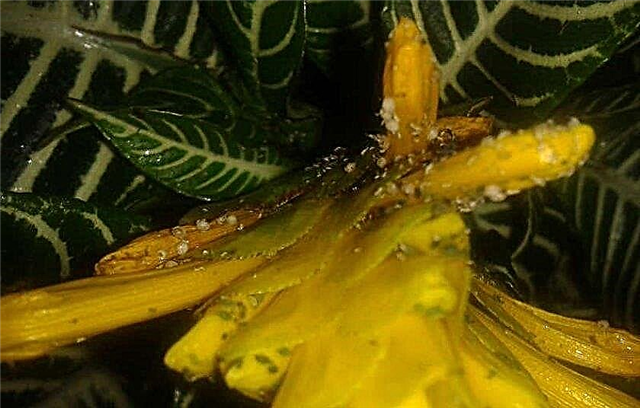
- Shield. The presence of brown plaques, as well as a sticky coating on the leaves, which begin to turn yellow and fall, speaks about her presence. The sheets are wiped with a sponge dipped in soapy water and treated with appropriate preparations (Inta-Vir or Actellik).
- False shield. It appears in the form of reddish-brown dots. The leaves of the plant are deformed and dry. Control measures are the same as when a scale insect was found.
 Scaffold and false scaffold
Scaffold and false scaffold - Spider mite. It can be detected by white blotches on the leaves and the appearance of a web. To combat it, humidity is increased and sprayed with the Aktara chemical product.
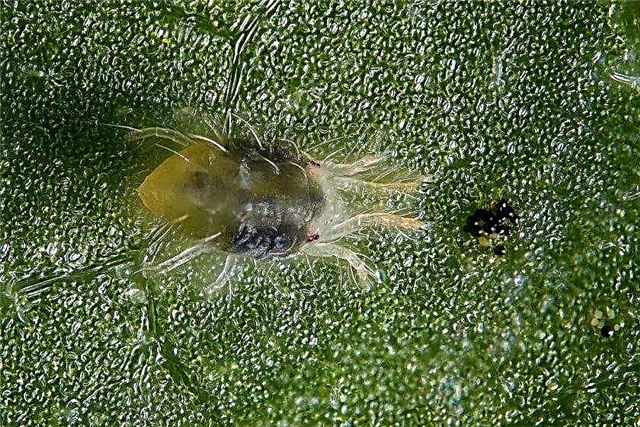
The meaning of the flower in the house
Afelandra in the house primarily performs a decorative function - after all, this plant is very beautiful, especially during the flowering period. An exotic flower will decorate any room and composition of indoor plants.
According to the zodiac sign, Alephander suits Leo. The representatives of this sign are perfectly matched by the bright flowers of yellow, red and orange.
Feng Shui has a positive attitude towards flowers growing up. It is believed that they activate positive energy.
Did you know? In the language of flowers, red is the color of life and love, but it can also express anger and desire for revenge. The yellow color indicates disgust and hatred, and the golden tone symbolizes the sun and joy. In the East, yellow is treated differently, considering it the color of wisdom.
Afelandra is a fast-growing plant with beautiful large leaves and luxurious flowering. So that the decorative appearance of this flower does not suffer, it must be well looked after, as it is demanding on the growing conditions, and regularly updated.







 Scaffold and false scaffold
Scaffold and false scaffold



